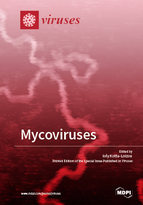Mycoviruses
A special issue of Viruses (ISSN 1999-4915). This special issue belongs to the section "Viruses of Plants, Fungi and Protozoa".
Deadline for manuscript submissions: closed (30 September 2018) | Viewed by 117073
Special Issue Editor
2. Department of Clinical, Pharmaceutical and Biological Science, University of Hertfordshire, Hatfield AL10 9AB, UK
Interests: mycoviruses; mycovirus infection; mycovirus population studies; mycovirus evolution; mycovirus–fungus interactions; bacterial gene expression; RNA damage and repair; oxidative stress; antibiotics resistance; CRISPR-Cas
Special Issues, Collections and Topics in MDPI journals
Special Issue Information
Dear Colleagues,
I am honoured to have been approached to act as the Guest Editor for a Special Issue dedicated to mycoviruses. My interest in viruses stems from their unique nature at the interface between living and non-living entities. The often underappreciated and overlooked mycoviruses in particular offered me the opportunity to discover novel types and explore unusual interactions in settings of medical, ecological and economical importance with potential biotechnological implications. I would like to invite you all to contribute to the Special Issue by submitting your recent works for publication, as an original research article, a short communication or a review. Population studies highlighting the diversity of mycoviruses in organisms and ecosystems, previously undescribed mycovirus families and investigations on mycovirus-host interactions, including but not limited to the role of RNA silencing in mycovirus infections, are most welcome. I am looking forward to hearing from you.
Yours sincerely,
Dr. Ioly Kotta-LoizouGuest Editor
Manuscript Submission Information
Manuscripts should be submitted online at www.mdpi.com by registering and logging in to this website. Once you are registered, click here to go to the submission form. Manuscripts can be submitted until the deadline. All submissions that pass pre-check are peer-reviewed. Accepted papers will be published continuously in the journal (as soon as accepted) and will be listed together on the special issue website. Research articles, review articles as well as short communications are invited. For planned papers, a title and short abstract (about 100 words) can be sent to the Editorial Office for announcement on this website.
Submitted manuscripts should not have been published previously, nor be under consideration for publication elsewhere (except conference proceedings papers). All manuscripts are thoroughly refereed through a single-blind peer-review process. A guide for authors and other relevant information for submission of manuscripts is available on the Instructions for Authors page. Viruses is an international peer-reviewed open access monthly journal published by MDPI.
Please visit the Instructions for Authors page before submitting a manuscript. The Article Processing Charge (APC) for publication in this open access journal is 2600 CHF (Swiss Francs). Submitted papers should be well formatted and use good English. Authors may use MDPI's English editing service prior to publication or during author revisions.
Keywords
- mycoviruses
- population studies
- mycovirus evolution
- mycovirus-host interactions
- RNA silencing
Related Special Issue
- Mycoviruses in Viruses (37 articles)







